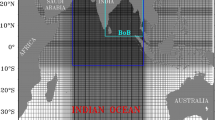Abstract
The effects of the mixing of wave transport flux residual (Bvl) on the upper ocean is studied through carrying out the control run (CR) and a series of sensitive runs (SR) with ROMS model. In this study, the important role of Bvl is revealed by comparing the ocean temperature, statistical analysis of errors and evaluating the mixed layer depth. It is shown that the overestimated SST is improved effectively when the wave-induced mixing is incorporated to the vertical mixing scheme. As can be seen from the vertical structure of temperature 28°C isotherm changes from 20 min CR to 35 m in SR3, which is more close to the observation. Statistic analysis shows that the root-mean-square errors of the temperature in 10 m are reduced and the correlation between model results and observation data are increased after considering the effect of Bvl. The numerical results of the ocean temperature show improvement in summer and in tropical zones in winter, especially in the strong current regions in summer. In August the mixed layer depth (MLD) which is defined as the depth that the temperature has changed 0.5°C from the reference depth of 10 m is further analyzed. The simulation results have a close relationship with undetermined coefficient of Bvl, sensitivity studies show that a coefficient about 0.1 is reasonable value in the model.
Similar content being viewed by others
References
Haidvogel, D. B., AraBeckmann, A., Malanotte-Rizzoli, P., and Shchepetkin, A. F., 2000. Model evaluation experiments in the North Atlantic Basin: Simulations in nonlinear terrain-following coordinates. Dynamics of Atmospheres and Oceans, 32: 239–281.
Kara, A. B., Wallcraft, A. J., and Hurlburt, H. E., 2003. Climatological SST and MLD predictions from a global layered ocean model with an embedded mixed layer. Journal of Atmospheric and Oceanic Technology, 20: 1616–1632.
Large, W. G., McWilliams, J. C., and Doney, S. C., 1994. Oceanic vertical mixing: A review and a model with a nonlocal boundary layer parameterization. Reviews of Geophysics, 32: 363–403.
Mellor, G. L., and Yamada, T., 1982. Development of a turbulence closure model for geophysical fluid problems. Reviews of Geophysics, 20: 851–875.
Price, J. F., Weller, R. F., and Pinkel, R., 1986. Diurnal cycling: Observations and models of the upper ocean response to diurnal heating, cooling and wind mixing. Journal of Geophysical Research, 91: 8411–8427.
Qiao, F. L., Yuan, Y. L., Yang, Y. Z., Xia, C. S., and Ma, J., 2004. Wave induced mixing in the upper ocean: Distribution and application to a global ocean circulation model. Geophysical Research Letters, 31, L11303, DOI: 10.1029/2004GL019824.
Schopf, P. S., and Loughe, A., 1995. A reduced-gravity isopycnal ocean model: Hindcasts of El Niño. Monthly Weather Review, 123: 2839–2863.
Wang, Y. G., Qiao, F. L., Fang, G. H., and Wei, Z. X., 2010. Application of wave-induced vertical mixing to the K profile parameterization scheme. Journal of Geophysical Research, 115, C09014, DOI: 10. 1029/2009JC005856.
Warner, J. C., Sherwood, C. R., Signell, R. P., Harris, C. K., and Arango, H. G., 2008. Development of a three-dimensional, regional, coupled wave, current, and sediment-transport model. Computers & Geosciences, 34: 1284–1306.
Wilkin, J. L., Arango, H. G., Haidvogel, D. B., Lichtenwalner, C. S., Glenn, S. M., and Hedstrom, K. S., 2005. A regional ocean modeling system for the long-term ecosystem observatory. Journal of Geophysical Research, 110: 0148–0227.
Yang, Y. Z., Qiao, F. L., Zhao, W., Teng, Y., and Yuan, Y. L., 2005. MASNUM ocean wave numerical model in spherical coordinates and its application. Acta Oceanologica Sinica, 22: 1–7.
Yang, Y. Z., Zhan, R., and Teng, Y., 2009. Parameterization of ocean wave-induced mixing processes for finite water depth. Acta Oceanologica Sinica, 28: 16–22.
Yuan, Y. L., Pan, Z. D., Hua, F., and Sun, L. T., 1991. LAGDFWAM numerical wave model. Acta Oceanologica Sinica, 10: 483–488.
Yuan, Y. L., Qiao, F. L., Hua, F., and Wan, Z. W., 1999. The development of a coastal circulation numerical model: 1. Wave-induced mixing and wave-current interaction. Journal of Hydrodynamics, 14: 1–8.
Yuan, Y. L., Qiao, F. L., Yin, X. Q., and Han, L., 2013. Analytical estimation of mixing coefficient induced by surface wavegenerated turbulence based on the equilibrium solution of the second-order turbulence closure model. Since China, 56: 71–80.
Author information
Authors and Affiliations
Corresponding author
Rights and permissions
About this article
Cite this article
Shi, Y., Wu, K. & Yang, Y. Preliminary results of assessing the mixing of wave transport flux residualin the upper ocean with ROMS. J. Ocean Univ. China 15, 193–200 (2016). https://doi.org/10.1007/s11802-016-2706-5
Received:
Revised:
Accepted:
Published:
Issue Date:
DOI: https://doi.org/10.1007/s11802-016-2706-5




